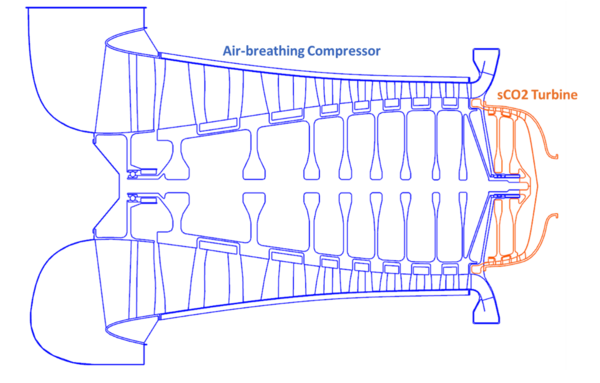
Introduction
Commercial aircraft have an environmental impact that will continue to grow as demand further increases. This is balanced by the many derived social benefits as air transport has become widely accessible to the world’s population. Work will continue developing alternative concepts such as electric and hydrogen propulsion systems, but until significant technical breakthroughs occur in these technologies, commercial air travel will continue to rely on gas turbine engines that burn fossil fuels.
Why are gas turbine engines used for most aero-propulsion applications?
Because of the immense amount of energy required during take-off for a modern commercial aircraft, the power to weight of the propulsion system as well as the specific energy (energy per mass) of the fuel is critically important. A gas turbine engine has an order of magnitude or higher power to weight ratio than competing power producing technologies. In this case, the laws of physics preclude alternatives based on available technologies.
Recent advances in gas turbine technologies
Significant advances particularly in the areas of environmental impact (emissions and noise) have occurred over the past several generations of commercial aircraft engines achieving fuel burn reductions on the order of 30% and emissions reductions on the order of 50%. Key contributors to these reductions include the development of high bypass ratio engines, increased engine temperatures, and significant investments in combustor design. However, we are again facing physical limits as the trajectory of these reductions are not projected to continue based on current engine configurations and technologies.
What is next?
Disregarding a technology discovery that totally revolutionizes commercial aircraft propulsion, the next logical steps include a more highly integrated aircraft and propulsion system that opens the current design space, resulting in increased propulsive efficiency coupled with cycle modifications; this results in higher thermal efficiencies achievable with simple gas turbine cycles. There has been a lot of interest in waste heat recovery cycles using various working fluids including supercritical Carbon Dioxide (sCO2). The ITAP engine architecture utilizes an sCO2 thermal and power management cycle and provides both higher thermal efficiency and an architecture supporting an integrated aircraft and propulsion system.
What is ITAP?
The Integrated Thermal Aero Propulsion (ITAP) engine is a novel gas turbine architecture that integrates a conventional air-breathing cycle for propulsion with a closed loop supercritical CO2 cycle. The proposed architecture as applied to a distributed propulsion system with an electrically driven propulsor is shown in the figure 1.

Figure 1 – Schematic of the ITAP Engine Architecture
The air system (shown in blue) follows from a typical gas turbine cycle with the air entering a compressor followed by a combustor and a turbine. The air exiting the turbine is cooled by a heat exchanger before exhausting to the atmosphere.
The integrated closed-loop cycle is shown in orange. Starting from the heat exchanger, the sCO2 temperature increases using the thermal energy recovered from the primary air flow exhaust, and the working fluid is additionally heated as it passes through the hot section components. The sCO2 is then expanded through a turbine. The fluid then passes through a second heat-exchanger to reduce the temperature before moving through an sCO2 compressor to complete the closed cycle.
In addition, this engine architecture uses the sCO2 rotating components to provide power transmission between the air-breathing compression and expansion components. This is accomplished by integrating the air-breathing compressor and the sCO2 turbine into a single component as shown in figure 2. Similarly, the air-breathing turbine and sCO2 compressor are integrated into a single component.

Figure 2 – Integrated Air-breathing Compressor and sCO2 Turbine
Benefits of the ITAP engine architecture
The NDTL team is beginning to explore the promise of the ITAP engine architecture. Cycle studies were executed comparing the fuel burn of the ITAP engine compared to a model representative of the latest generation of narrow-body engines which shows a 9 – 18% improvement in fuel burn for various mission points as shown in Figure 3.

Figure 3 – Fuel Burn Benefit of the ITAP Architecture
The primary drivers of the fuel burn benefit are the waste heat recovery from the engine exhaust via the heat exchanger and utilization of the sCO2 working fluid as a heat sink for the engine hot section components, reducing the engine cooling flow requirements.
The ITAP engine architecture supports a lower pressure ratio cycle providing two significant benefits. The compression system can be simplified reducing the number of components and the number of blade rows. Additionally, the compressor exit temperature is reduced mitigating a materials / cooling issue at the rear end of compressors in high overall pressure ratio engines.
The ITAP architecture also supports a modular system where the major air-breathing components (compressor, combustor, turbine) are exclusively interconnected with fluid ducting and piping. This provides extensive freedom in the packaging of the engine within the aircraft and would support vibration and shock isolation for the rotating components, allowing tighter clearances that could be preserved throughout the life of the engine. Additionally, a modular system would have great impact for the aftermarket, particularly if turbine modules could be swapped without engine removals.
Summary
The NDTL team is working to develop the technologies for the next generation of aero-propulsion engines with a focus on reducing environmental impact. An alternative to a conventional gas turbine engine architecture based on an sCO2 thermal and power management cycle highly integrated with an air-breathing gas turbine cycle is proposed. The ITAP engine builds off the decades of investment and experience in conventional gas turbine engines and leverages demonstrated technology and the on-going investment in sCO2 thermal and power management cycles. The technology has the potential to provide a significant level of fuel burn reduction coupled with system benefits that provide additional value for propulsion applications.
Originally published by at turbo.nd.edu on August 26, 2022.